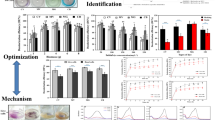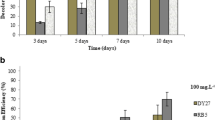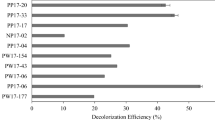Abstract
Forty-two white-rot fungi in submerged cultures were tested to determine their dye decolorization capacity and the optimal conditions for the decolorization process. Trametes pubescens Cui 7571 was found to be the most effective strain in terms of decolorization performance on the azo dye Congo Red, and it exhibited excellent reusability as well as persistence in sequential decolorization experiments. Optimization of the decoloration process was also conducted to evaluate the effects of a number of chemical compounds, metal salts, inducers, and mediators on the dye decolorization rate. On the seventh day, a highest dye removal of 98.83 % was observed with addition of copper at 2.5 mmol L−1, Tween 80 at 1.0 % (v/v), and ferulic acid at 0.50 μmol L−1, respectively. The adsorption of mycelia to dyes was not a significant contributor to dye removal, and decolorization by the functional fungus T. pubescens depended on biodegradation by enzymes, as evidenced by the results of the moist heat sterilization treatment (121°C for 20 min), induction of extracellular enzymes, and scanning electron microscopy. Four dye degradation metabolites, i.e., naphthalene amine, biphenyl amine, biphenyl ,and naphthalene diazonium, were identified by Fourier transform infrared spectroscopy and gas chromatography-mass spectrometry. The phytotoxicity tests indicated that degraded metabolites had almost a negligible effect on the plant seeds as compared to that of dye, which is indicative of the less toxic nature of the metabolites. Our results suggest that white-rot fungus T. pubescens could be developed into a novel azo dye bioremediation strategy.




Similar content being viewed by others
References
Banat IM, Nigam P, Singh D, Marchant R (1996) Microbial decolorization of textile-dye-containing effluents: a review. Bioresour Technol 58:217–227
Casieri L, Varese GC, Anastasi A, Prigione V, Svobodová K, Marchisio VF, Novotný C (2008) Decolorization and detoxication of reactive industrial dyes by immobilized fungi Trametes pubescens and Pleurotus ostreatus. Folia Microbiol 53:44–52
Chen JP, Yang L (2006) Study of a heavy metal biosorption onto raw and chemically modified Sargassum sp. via spectroscopic and modeling analysis. Langmuir 22:8906–8914
Dai YC (2011) A revised checklist of corticioid and hydnoid fungi in China for 2010. Mycoscience 52:69–79
Dai YC (2012) Polypore diversity in China with an annotated checklist of Chinese polypores. Mycoscience 53:49–80
Daneshvar N, Ayazloo M, Khataee AR, Pourhassan M (2007) Biological decolorization of dye solution containing Malachite Green by microalgae Cosmarium sp. Bioresour Technol 98:1176–1182
Dhanve RS, Kalyani DC, Phugare SS, Jadhav JP (2009) Coordinate action of exiguobacterial oxidoreductive enzymes in biodegradation of reactive yellow 84A dye. Biodegradation 20:245–255
Elissetche JP, Ferraz A, Freer J, Mendonça R, Rodríguez J (2006) Thiobarbituric acid reactive substances, Fe3+ reduction and enzymatic activities in cultures of Ganoderma australe growing on Drimys winteri wood. FEMS Microbiol Lett 260:112–118
Enayatizamir N, Tabandeh F, Rodríguez-Couto S, Yakhchali B, Alikhani HA, Mohammadi L (2011) Biodegradation pathway and detoxification of the diazo dye Reactive Black 5 by Phanerochaete chrysosporium. Bioresour Technol 102:10359–10362
Fabbrini M, Galli C, Gentili P (2002) Comparing the catalytic efficiency of some mediators of laccase. J Mol Catal B Enzym 16:231–240
Ghodake G, Jadhav S, Dawkar V, Govindwar S (2009) Biodegradation of diazo dye Direct brown MR by Acinetobacter calcoaceticus NCIM 2890. Int Biodeterior Biodegrad 63:433–439
González LF, Sarria V, Sánchez OF (2010) Degradation of chlorophenols by sequential biological-advanced oxidative process using Trametes pubescens and TiO2/UV. Bioresour Technol 101:3493–3499
Goszczynski S, Paszczynski A, Pasti-Grigsby MB, Crawford RL (1994) New pathway for degradation of sulfonated azo dyes by microbial peroxidases of Phanerochaete chrysosporium and Streptomyces chromofuscus. J Bacteriol 176:1339–1347
Heinzkill M, Bech L, Halkier T, Schneider P, Anke T (1998) Characterization of laccases and peroxidases from wood-rotting fungi (Family Coprinaceae). Appl Environ Microbiol 64:1601–1606
Jadhav SB, Phugare SS, Patil PS, Jadhav JP (2011) Biochemical degradation pathway of textile dye Remazol red and subsequent toxicolog ical evaluation by cytotoxicity, genotoxicity and oxidative stress studies. Int Biodeterior Biodegrad 65:733–743
Jin R, Zhou J, Zhang A, Wang J (2008) Bioaugmentation of the decolorization rate of acid red GR by genetically engineered microorganism Escherichia coli JM 109 (pGEX-AZR). World J Microbiol Biotechnol 24:23–29
Kalme SD, Ghodake GS, Govindwar SP (2007) Red HE7B degradation using desulfonation by Pseudomonas desmolyticum NCIM 2112. Int Biodeterior Biodegrad 60:327–333
Kalyani DC, Patil PS, Jadhav JP, Govindwar SP (2008) Biodegradation of reactive textile dye Red BLI by an isolated bacterium Pseudomonas sp. SUK1. Bioresour Technol 99:4635–4641
Kissi M, Mountadar M, Assobhei O, Gargiulo E, Palmieri G, Giardina P, Sannia G (2001) Roles of two white-rot basidiomycete fungi in decolorisation and detoxification of olive mill waste water. Appl Microbiol Biotechnol 57:221–226
Liu L, Sun J, Li M, Wang S, Pei H, Zhang J (2009) Enhanced enzymatic hydrolysis and structural features of corn stover by FeCl3 pretreatment. Bioresour Technol 100:5853–5858
Lu Y, Yan LH, Wang Y, Zhou SF, Fu JJ, Zhang JF (2009) Biodegradation of phenolic compounds from coking wastewater by immobilized white rot fungus Phanerochaete chrysosporium. J Hazard Mater 165:1091–1097
Marco-Urrea E, Pérez-Trujillo M, Vicent T, Caminal G (2009) Ability of white-rot fungi to remove selected pharmaceuticals and identification of degradation products of ibuprofen by Trametes versicolor. Chemosphere 74:765–772
Mittal A, Kurup L, Gupta VK (2005) Use of waste materials bottom ash and de-oiled soya, as potential adsorbents for the removal of Amaranth from aqueous solutions. J Hazard Mater 117:171–178
Molina S, Rencoret J, del Río JC, Lomascolo A, Record E, Martínez AT, Gutiérrez A (2008) Oxidative degradation of model lipids representative for main paper pulp lipophilic extractives by the laccase-mediator system. Appl Microbiol Biotechnol 80:211–222
Munari FM, Gaio TA, Calloni R, Dillon AJP (2008) Decolorization of textile dyes by enzymatic extract and submerged cultures of Pleurotus sajor-caju. World J Microbiol Biotechnol 24:1383–1392
Papinutti L, Forchiassin F (2010) Adsorption and decolorization of dyes using solid residues from Pleurotus ostreatus mushroom production. Biotechnol Bioproc Eng 15:1102–1109
Park C, Lee Y, Kim T, Lee M, Lee B, Lee J, Kim S (2003) Enzymatic decolorization of various dyes by Trametes versicolor KCTC 16781. Korean J Biotechnol Bioeng 18:398–403
Parshetti G, Kalme S, Saratale G, Govindwar S (2006) Biodegradation of malachite green by Kocuria rosea MTCC 1532. Acta Chim Slov 53:492–498
Revankar MS, Lele SS (2007) Synthetic dye decolorization by white rot fungus, Ganoderma sp. WR-1. Bioresour Technol 98:775–780
Robinson T, McMullan G, Marchant R, Nigam P (2001) Remediation of dyes in textile effluent: a critical review on current treatment technologies with a proposed alternative. Bioresour Technol 77:247–255
Roriz MS, Osma JF, Teixeira JA, Rodríguez-Couto S (2009) Application of response surface methodological approach to optimise Reactive Black 5 decolouration by crude laccase from Trametes pubescens. J Hazard Mater 169:691–696
Shah PD, Dave SR, Rao MS (2012) Enzymatic degradation of textile dye Reactive Orange 13 by newly isolated bacterial strain Alcaligenes faecalis PMS-1. Int Biodeterior Biodegrad 69:41–50
Sharma KK, Kuhad RC (2008) Laccase: enzyme revisited and function redefined. Indian J Microbiol 48:309–316
Silva IS, Grossman M, Durrant LR (2009) Degradation of polycyclic aromatic hydrocarbons (2-7 rings) under microaerobic and very-low-oxygen conditions by soil fungi. Int Biodeterior Biodegrad 63:224–229
Singh G, Capalash N, Goel R, Sharma P (2007) A pH-stable laccase from alkali-tolerant γ-proteobacterium JB: purification, characterization and indigo carmine degradation. Enzyme Microb Technol 41:794–799
Stanescu MD, Gavrilas S, Ludwig R, Haltrich D, Lozinsky VI (2012) Preparation of immobilized Trametes pubescens laccase on a cryogel-type polymeric carrier and application of the biocatalyst to apple juice phenolic compounds oxidation. Eur Food Res Technol 234:655–662
Šušla M, Novotný Č, Erbanová P, Svobodová K (2008) Implication of Dichomitus squalens manganese-dependent peroxidase in dye decolorization and cooperation of the enzyme with laccase. Folia Microbiol 53:479–485
Tsioulpas A, Dimou D, Iconomou D, Aggelis G (2002) Phenolic removal in olive oil mill wastewater by strains of Pleurotus spp. in respect to their phenol oxidase (laccase) activity. Bioresour Technol 84:251–257
Wesenberg D, Kyriakides I, Agathos SN (2003) White-rot fungi and their enzymes for the treatment of industrial dye effluents. Biotechnol Adv 22:161–187
Yang X, Wang J, Zhao X, Wang Q, Xue R (2011) Increasing manganese peroxidase production and biodecolorization of triphenylmethane dyes by novel fungal consortium. Bioresour Technol 102:10535–10541
Zhuo R, Ma L, Fan F, Gong Y, Wan X, Jiang M, Zhang X, Yang Y (2011) Decolorization of different dyes by a newly isolated white-rot fungi strain Ganoderma sp. En3 and cloning and functional analysis of its laccase gene. J Hazard Mater 192:855–873
Acknowledgments
The study was supported by the Program for New Century Excellent Talents in University (NCET-11-0585).
Author information
Authors and Affiliations
Corresponding author
Rights and permissions
About this article
Cite this article
Si, J., Cui, BK. & Dai, YC. Decolorization of chemically different dyes by white-rot fungi in submerged cultures. Ann Microbiol 63, 1099–1108 (2013). https://doi.org/10.1007/s13213-012-0567-8
Received:
Accepted:
Published:
Issue Date:
DOI: https://doi.org/10.1007/s13213-012-0567-8




